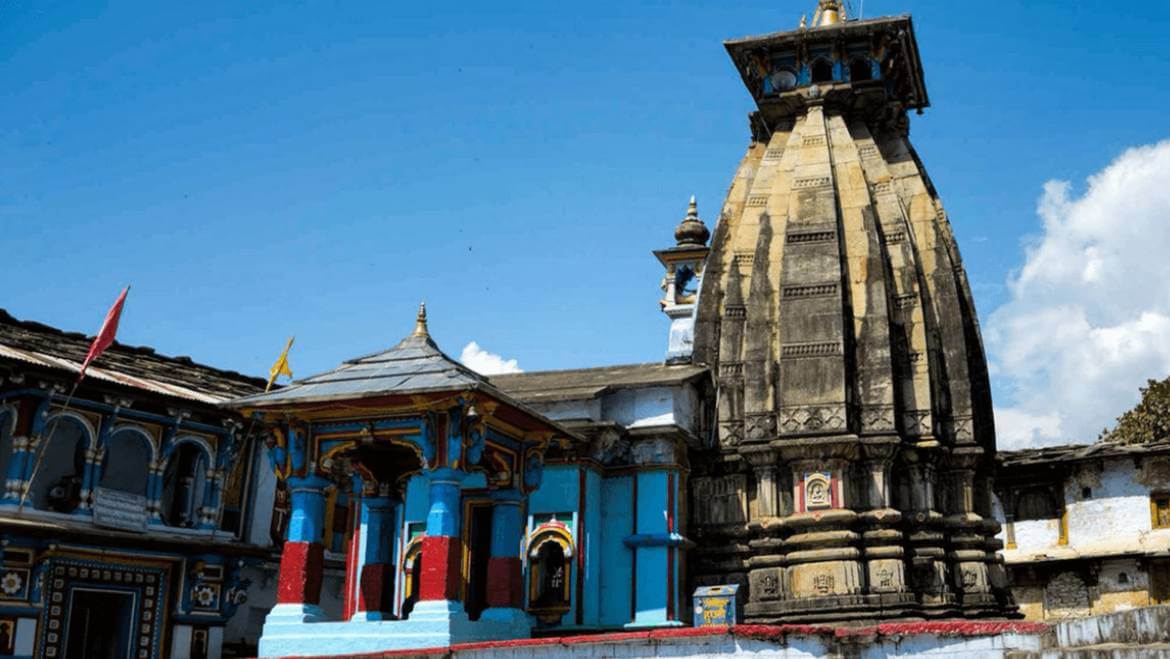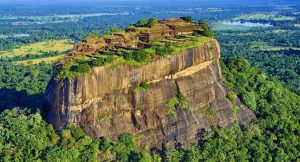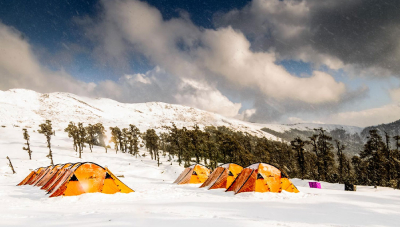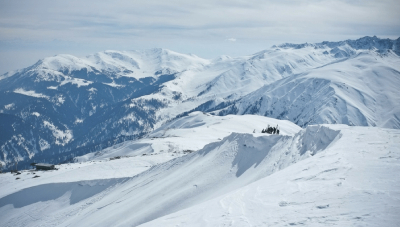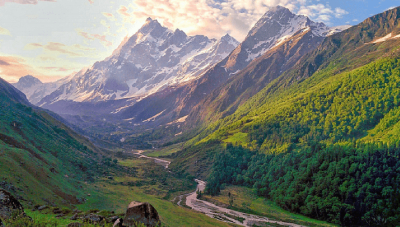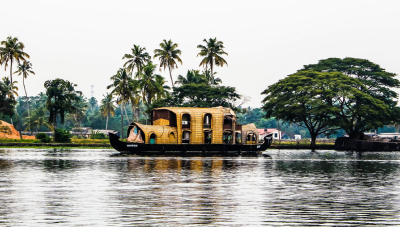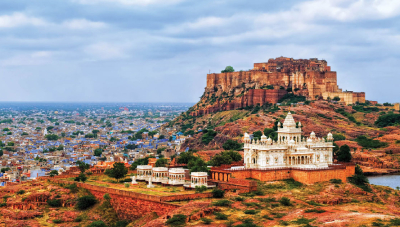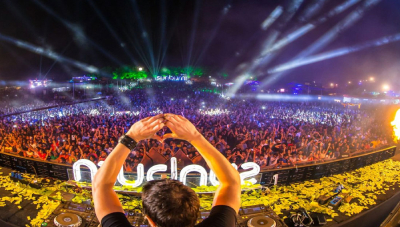With a plethora of religious sites, India makes it a perfect destination for spiritual tours to seek peace of mind and tranquility. Amongst all the spiritual tours, the ‘Chota Char Dham Yatra of Uttarakhand’ holds a great religious significance, especially for Hindus as it is believed that whosoever does this yatra once in his lifetime is relieved from the cycle of life and death and attains salvation. Pilgrims and travel enthusiasts from within India and different corners of the world travel to Uttarakhand in huge numbers every year to seek spiritual bliss that is offered in the Chota Char Dham tour.
The ‘Char Dham Yatra’ usually commences from the holy city of Haridwar, which is an important pilgrimage center for Hindus and millions of devotees. Many believers visit this place every year to take a holy dip in the sacred waters of River Ganga to sanctify themselves. Similar to Haridwar, there are many places in Uttarakhand that play an important role in keeping the Hindu faith strong and these places can indeed be visited during the performance of the main Chota Char Dham Yatra. In other words, one may say that this sacred Yatra is one of the best ways to explore the mighty land of Uttarakhand. So, if one receives the ‘Calling’, he and she must not stop himself but embark on this journey, which certainly has the potential to change one’s perspective towards religion and faith. This is absolutely the right time to dive deep into the realm of spirituality. The opening dates of Char Dham Sites are-
- Gangotri Dham Opening Date – 10 May 2024
- Yamunotri Dham Opening Date – 10 May 2024
- Kedarnath Dham Opening Date – 10 May 2024
- Badrinath Dham Opening Date – 12 May 2024
While, most of the below mentioned places can be explored enroute the four major pilgrimage spots, there are other places for which one must spare some time.
Best Selling Char Dham Yatra Tour Packages
Haridwar & Rishikesh

- Har Ki Pauri – According to the Hindu mythology, it is at ‘Har ki Pauri’ in Haridwar that king Bhagirath performed a penance to Lord Shiva in order to rescue souls of his ancestors from vicious circle of rebirth. Pleased with his prayers, Lord Shiva asked holy river Ganga to flow through his locks. Bhagirath took a dip in the holy waters of river Ganga and rescued the souls of his ancestors from their sins. Since then, thousands of devotees take a dip at ‘Har ki Pauri’ to pray for salvation of their ancestors.
- Mansa Devi Temple – The temple is perched on a hill top and can be reached through a cable car ride. It is believed that Goddess Mansa fulfils the wishes of her devotee, so, lots of pilgrims flock to the temple to have their wishes fulfilled from the Goddess. Devotees tie a thread with their wish to the branches of a sacred tree in the temple and when the wish gets fulfilled, they come back again to untie the thread from the tree.
- Chandi Devi Temple – Located on top of the Neel Parvat, the ‘Chandi Devi’ temple can be reached through a bus from Mansa Devi temple. The temple is dedicated to Goddess Chandika Devi and is considered to be one of the Siddha peethas of Haridwar where the wishes of true devotees get fulfilled.
- Ganga Aarti – The sacred ‘Ganga Aarti’ is performed on the ghats of ‘Har ki Pauri’ during evening. Vedic hymns and prayers recited during the aarti create a divine atmosphere all around giving a feel of peace and solace to your souls. Enchanting views of hundreds of thousands of lighted diyas floating on the waters of Ganga during the aarti just adds to the magical charm of the whole aura.
- Neelkanth Mahadev Temple, Rishikesh– The temple is dedicated to Lord Shiva who is revered here in the form of Neelkanth. As per puranic legends, it is at this place where Lord Shiva consumed the poison that originated from Samudra Manthan. The poison turned his throat (kanth) blue (neel) and hence the name Neelkanth.
- Trimbakeshwar Temple, Rishikesh– One of the most famous temples of Rishikesh, the ‘Trimbakeshwar Temple’ is a 13 storeyed building with each floor having a shrine of different form of Lord Shiva. The temple can be reached by crossing the Laxman Jhula. Hundreds of pilgrims visit this temple every day.
- Triveni Ghat, Rishikesh– The ghat is located on the confluence of three holy rivers: Ganga, Yamuna and Saraswati. It is believed that taking a holy dip in the waters of the triveni confluence can wash off all your sins. Main attraction of the Triveni Ghat is its Maha Aarti that is held during twilight. The aarti and fragrance of incense fills the air with spirituality and mysticism.
From Haridwar, two different routes can be taken to Yamunotri & Gangotri. First route takes you through Dehradun – Mussoorie – Barkot. The second route is via Rishikesh – Uttarkashi.
Other Interesting Blogs to Read
Here are Some Must-Visit Places Enroute to Yamunotri-Gangotri via First Route
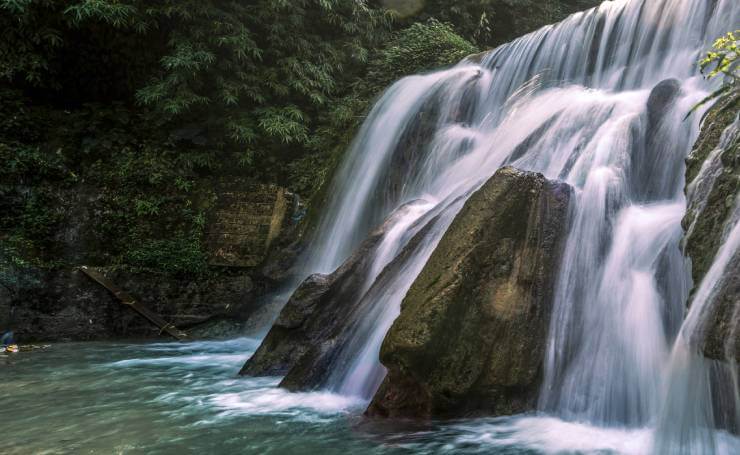
- Lachhiwala, Dehradun– The place is considered to be one of the best picnic spots near Dehradun. Pilgrims heading to Yamunotri can spend few hours here enjoying pleasant weather and bird watching.
- Sahastradhara, Dehradun– A serene place to rejuvenate your mind and soul, Sahastradhara is a water spring known for its medicinal values. Aesthetic beauty and calm weather make it a perfect destination to stop by for couple of hours enroute to Yamunotri.
- Robber’s Cave, Dehradun – Also known as Guchhupani, Robber’s Cave is believed to be the place where robbers used to hide in olden times. A cold-water spring flows through the cave which disappears at a point and then reappears at a spot further. One can also see beautiful waterfalls at few places inside the cave.
- Kempty Falls, Mussoorie– Enroute to Yamunotri, you can also stop by at the famous Kempty Falls in Mussoorie. Known to be the best picnic spot in Mussoorie, it is an ideal place to take a refreshing bath under the chilled waters of the gushing waterfall. You can also indulge in some boating at the nearby Mussoorie Lake.
- Barkot– Barkot is a small hill station enroute to Yamunotri and makes for an important stopover during the ‘Char Dham Yatra’. Panoramic vistas of the snow-covered ‘Bandarpoonch Peak’ of the Garhwal Himalayas are best seen from here. An ancient ‘Shiva Temple’ is the major tourist attraction in Barkot.
- Hanuman Chatti– Hanuman Chatti is the base camp for three trekking excursions: Yamunotri, Dodi Tal and Darwa Top. Located on the confluence of River Yamuna and Hanuman Ganga and enclosed by snow-capped Himalayan peaks, Hanuman Chatti is a perfect place to feel nature at its best. A small ‘Hanuman Temple’ is visited by all the tourists stopping by at Hanuman Chatti. From ‘Hanuman Chatti’, a jeep or taxi can be hired to reach ‘Janki Chatti’ from where the real climb of 6 km. starts to Yamunotri.
- Janki Chatti – Janki Chatti is the last motorable stop enroute to Yamunotri and from here, the actual climb to Yamunotri begins. The place is also known for its hot water springs where devotees can take bath and get rid of all the fatigue and tiredness of the journey. From Janki Chatti to Yamunotri, the climb is of around 6 km. Youngsters and fit pilgrims can cover the climb on foot. For pilgrims who are not fit enough to ascent on foot, ponies and palanquins are available that can be hired on rent. Panoramic vistas of snow-covered mountains, sparkling rivulets, spurting waterfalls and dense forests that are offered during the climb to Yamunotri fills your hearts with serenity and peace.
- Kharsali – At just a distance of 1 km. from Janki Chatti, the small town of Kharsali is famous for its oldest ‘Shani Dev Temple’. Many devotees of Lord Shani pay homage to this temple and proceed further to Yamunotri. Also, during winters when Yamunotri Temple is closed, idol of Goddess Yamuna is brought at this temple and is worshipped for 6 months till the time Yamunotri Temple reopens.
Other Interesting Blogs to Read
Top Places to Visit in and around Yamunotri
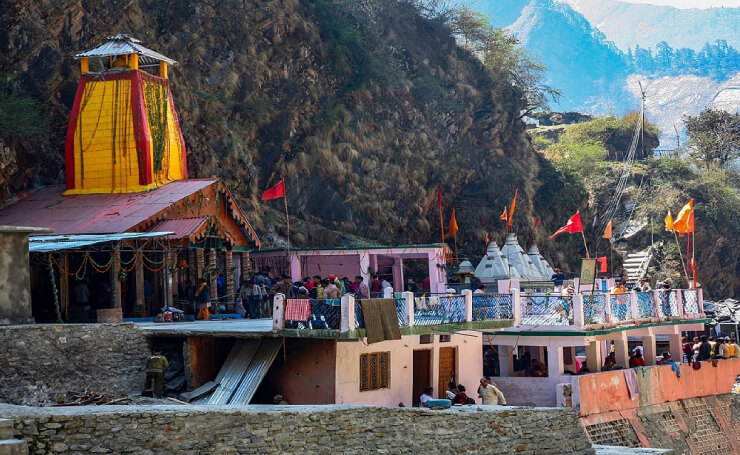
Yamunotri, the first Dham of the ‘Char Dhams’ is the holy abode of Goddess Yamuna. It is from here that River Yamuna originates. As per the Hindu mythological beliefs, Goddess Yamuna is the sister of Lord Yama (God of Death) and hence, taking a dip in holy waters of Yamuna brings a painless death. Following are the must-see places in Yamunotri.
- Surya Kund– A natural hot water spring named after the Sun (Surya) God, father of Goddess Yamuna. On reaching Yamunotri, pilgrims first need to take bath in the ‘Surya Kund’ and prepare rice and potatoes by tying them in a cloth that is dipped in the hot waters of the spring. The rice and potatoes are offered during Pooja at the main Yamunotri temple and remaining of it is later taken home as Prasad by the pilgrims.
- Divya Shila– It is a rock pillar located near the Surya Kund. As per rituals, devotees first need to pay homage at the ‘Divya Shila’ before entering the main shrine of the ‘Yamunotri Temple’.
- Yamunotri Temple– This is the main temple where Goddess Yamuna is revered in the form of a silver idol.
- Champasar Glacier– Actual point of origin is the ‘Champasar Glacier’ which is further few km. above the main temple. Due to a steep climb and limited accessibility, most pilgrims pay homage in the main temple only and return.
- Prakateshwar Cave– This mysterious cave falls enroute to Uttarkashi from Barkot. Famous for its limestone formation resembling the Shivlinga, this cave is visited by many pilgrims on their way to Gangotri.
After getting divine darshans of Yamunaji at Yamunotri, pilgrims usually head back to Uttarkashi and from there; further make their journey towards other Dhams in the ‘Char Dham Circuit’.
Other Interesting Blogs to Read
Best Places to Visit in and around Uttarkashi
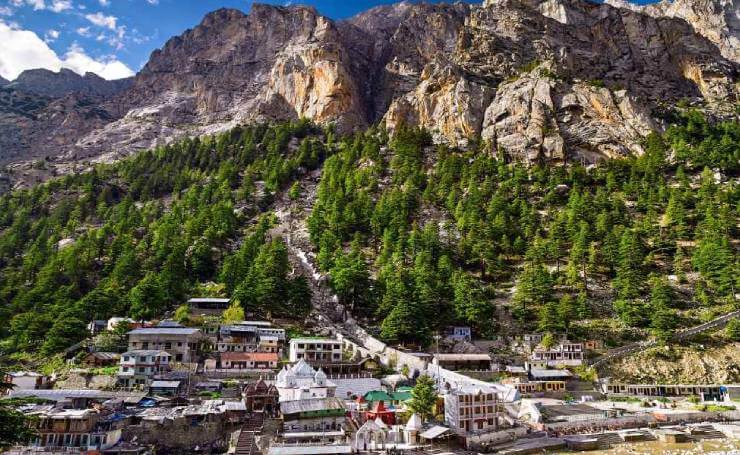
This is an ancient holy city located on the banks of River Bhagirathi. Uttarkashi is adorned with many beautiful temples and ashrams. Pilgrims heading to Gangotri usually stop by at Uttarkashi for a day to seek blessings from the God. Here are some best places to see in Uttarkashi.
- Vishwanath Temple– This temple is the oldest and most sacred shrine dedicated to Lord Shiva. According to the legends, Lord Shiva appeared here to save Rishi Markandeya from Yama, the God of death. The temple houses a ‘swayambhu lingam’, idols of Goddess Parvati, Lord Ganesh and Rishi Markandeya sitting in a meditative position.
- Shakti Temple– Opposite the Vishwanath Temple is the ‘Shakti Temple’, dedicated to Goddess Durga. Pilgrims visit this temple to seek blessings from Goddess Durga and to have a look at the heavy trident which is revered here in the form of ‘Shakti’.
- Gangnani – It is a small town situated enroute to Gangotri and is famous for its natural thermal water spring known as ‘Rishikund Teerth’. Pilgrims heading to Gangotri usually stop by and take the holy bath in the warm waters of the spring.
- Harsil – This hidden jewel of Uttarakhand is situated on the banks of the Bhagirathi River. Unspoilt natural charm, fresh mountain air and salubrious weather makes it a perfect place to stop by for few hours enroute to Gangotri. An interesting attraction near Harsil is ‘Sattal’, a breathtakingly beautiful cluster of high-altitude alpine lakes that can be reached through a 7 km. trek from Harsil.
- Dharali – Located at a distance of 2km. from Harsil, Dharali is another picturesque village famous for its apple orchards. Striking views of these Apple Orchards all along the route to Gangotri seem to be embracing you with their open arms. Another famous attraction of this small town is the ancient ‘Shiva Temple’ that is flocked by many pilgrims enroute.
- Mukhba Village – This pretty little village near Dharali is the home for Goddess Ganga where she is worshipped for almost 6 months owing to the closure of the main Gangotri Temple during peak winters. Small rustic wooden huts, trees of pine and rhododendrons, and vibrant coloured flowers all around; seem to have directly come out from a picture postcard. When at Mukhba Village, you can visit the ‘Ganga Temple’ where idol of Goddess Ganga is housed during winters.
- Bhairon Ghati – This scenic valley lies around 10km. before Gangotri, sitting on the confluence of Bhagirathi River and Jat Ganga. Adorned with pine trees and gargling Bhagirathi gushing down the mountains, the valley is famous for its ancient ‘Bhairon Temple’ that is visited by many pilgrims on the ‘Char Dham Yatra’.
Other Interesting Blogs to Read
Top Places to See in Gangotri

The second ‘Dham’ of the ‘Char Dham Yatra’ is ‘Gangotri’, the holy abode of River Goddess Ganga, the most sacred river for Hindus. The river takes her course from the ‘Gaumukh Glacier’ that lies 18 km. ahead of the Gangotri town. The river here is known as Bhagirathi till it merges with River Alaknanda at Devprayag from where she is referred to as River Ganga. The Gaumukh Glacier resembles a cow’s face and therefore, it is called so. According to the Hindu mythological beliefs, River Ganga appeared on earth to absolve the sins of king Bhagirath’s ancestors and since then, pilgrims take dip in the holy waters of this sacred river to get rid of their sins and attain salvation. Following is the list of must-see places in Gangotri.
- Gangotri Temple – This is the main shrine dedicated to Goddess Ganga. Serene and tranquil settings of the temple provide you with inner peace and solitude.
- Submerged Shivlinga – This is a natural rock Shivlinga submerged under water and is visible when the water level decreases during certain time periods. As per the beliefs, the place where Shivlinga resides, Lord Shiva sat to receive River Ganga in his matted locks to minimise the devastating effect on earth from her majestic flow.
- Suryakund Waterfalls – Another most famous attraction in Gangotri is the picturesque ‘Suryakund Waterfall’ that is located half a kilometre ahead of the Gangotri Temple.
- Pandava Gufa – Walk past the Suryakund waterfall in the forest for around 2 km. to reach the Pandava Cave. It is believed that Pandavas of Mahabharata stayed in the cave during their ascent to heaven after the battle.
- Bhagirathi Shila – It is the holy rock near the banks of Bhagirathi where King Bhagirath prayed to Lord Shiva.
- Gaumukh Glacier– ‘Gaumukh Glacier’ is another must-see place in Gangotri. To visit Gaumukh, you need to trek uphill a distance of 18km. on foot from Gangotri and take special permits from the forest department office in Uttarkashi as the route is quite prone to landslides. Panoramic views of the surrounding Himalayan peaks and beautiful meadows will enamour you in the mood of spirituality.
- Tapovan and Nandanvan – From Gaumukh, few courageous people also head towards the scenic sites of Tapovan and Nandanvan from where the views of Shivling Peak are just indescribable in words. These treks are quite arduous and one needs to be mentally prepared for accidents and natural calamities.
After the divine darshans of Gangaji at Gangotri, the journey to the third Char Dham of Kedarnath begins. Two routes to Kedarnath can be taken from Uttarkashi. First route takes you through Srinagar – Rudraprayag – Augustmuni – Ukhimath – Guptkashi – Sonprayag – Gaurikund.
The second route takes you through- Gangotri – Uttarkashi – Tehri – Mayali – Ghanshali – Ukhimath – Guptkashi – Sonprayag – Kedarnath.
Also Read: Significance of Chardham
Best Places to See in and around Ukhimath
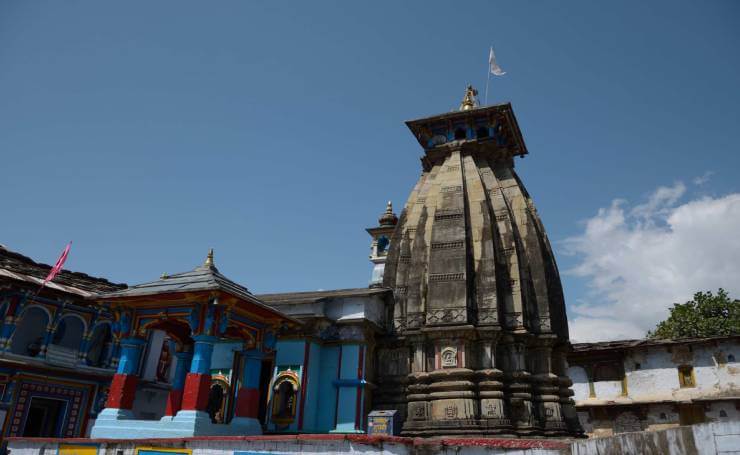
This is a little village where deities of Lord Kedarnath and Lord Madhyamaheshwar are worshipped during winters when the main temples of Kedarnath and Madhyamaheshwar remain closed. Here are few main attractions of Ukhimath.
- Omkareshwar Temple – Shrine where deities of Lord Kedarnath and Lord Madhyamaheshwar are worshipped.
- Madhyamaheshwar Temple – Another holy temple of the ‘Panch Kedar’ group, the temple is located at the place where the belly part of Lord Shiva fell during his run from the Pandavas.
- Kali Math Temple – Considered to be one of the 108 divine Shakti Peeths, the ‘Kalimath Temple’ is dedicated to Goddess Kali. It is believed that Goddess Kali here, killed the demon, Raktabeej. Thousands of pilgrims visit this temple every year.
Also Read: Char Dham Opening & Closing Dates
Top Places to Visit in and around Guptkashi

Guptkashi is a picturesque town situated on the banks of River Mandakini and snuggled between the Chaukhamba peaks of Garhwal Himalayan range. As per mythological legends, Gupt Kashi is the place where Lord Shiva proposed Goddess Parvati for their marriage. A second legend behind Gupt Kashi goes back to the days of Mahabharata when Pandavas, after the battle, prayed to Lord Shiva to relieve them from the agony of fratricide. Lord Shiva avoided meeting them and hid himself in Gupt Kashi in the form of Nandi bull. When Pandavas reached Gupt Kashi, they recognized Shiva in the form of bull and tried to hold him by its tail and hind legs. That very moment, Lord Shiva disappeared from Gupt Kashi. As Lord Shiva secretly hid himself here, the town has got the prefix of ‘Gupt’ to its name.
Following are the Main Attractions in Guptkashi
- Vishwanath Temple – As mentioned above, the ‘Vishwanath Temple’ is home to the original Shivlinga of Lord Shiva that is believed to have been brought from the Vishwanath Temple in Kashi when the temple was attacked by the Mughal Emperor, Aurangzeb. Many pilgrims gather here is huge numbers to seek blessings of the God.
- Ardhanarishwar Temple – The ‘Ardhanarishwar Temple’, located near the main Vishwanath Temple, houses the deity of Lord Shiva and Goddess Parvati in the form of half man and half woman.Manikarnika Kund– Manikarnika Kund also holds a great religious significance as the Shivlinga residing in the centre of the kund is bathed by waters of two springs representing Ganga and Yamuna.
- Sonprayag – It is another small enchanting town situated on the confluence of holy rivers Basuki and Mandakini. The ‘Triyuginarayan Temple’ in the village of Triyugi near Sonprayag is a famous temple dedicated to Lord Vishnu. As per the puranic legends, this is the place where Lord Shiva married to Goddess Parvati in front of Lord Vishnu.
- Gaurikund – This place is located 15km. ahead of Gupt Kashi and is the base site from where the trek of around 20 km. needs to be commenced to reach Kedarnath. Pilgrims first take bath in the hot waters of the Gaurikund and pay homage in the ‘Gauri Temple’ before proceeding with their journey to Kedarnath. As per mythological beliefs, Gaurikund is the place where Goddess Parvati meditated to attain Lord Shiva as her husband. According to a second belief, Lord Shiva blessed Lord Ganesha with the elephant head at this sacred site of Gaurikund.
From Gaurikund, either pilgrims can choose to trek on foot or hire ponies and palanquin services to reach the town of Kedarnath, perched at a height of 11,700 ft. above sea level. Many private helicopter services also operate at Gaurikund enabling pilgrims to take helicopter rides up to Kedarnath.
Also Read: Panch Kedar Temple Information
Top Tourist Attractions in Kedarnath

The third Dham of the ‘Char Dhams’, Kedarnath is the place where according to Hindu beliefs, Lord Shiva appeared in front of Pandavas in the form of a triangular Jyotirlinga to absolve them from the sins of killing their own brothers and many sages during the battle of Mahabharata. Following are main tourist attractions of Kedarnath.
Kedarnath Temple – It is the main shrine of Kedarnath, considered to be the home to one of the 12 Jyotirlingas of Lord Shiva. Also, revered as one of the ‘Panch Kedars’, the temple is visited by thousands of pilgrims all across the world. Perched on the head of River Mandakini and flanked by the breath-taking vistas of the Kedar and Swargarohini peaks of the Garhwal Himalayas, a visit to the Kedarnath Temple fills hearts of all devotees with divinity and spirituality.
Vasuki Tal – This is a sacred lake where Lord Vishnu is believed to have bathed in ancient times. The Tal can be reached through an 8 km. challenging trek from the Kedarnath Temple.
Bhairav Temple – Dedicated to Lord Bhairavnath, who is believed to be the guardian deity of Kedarnath town and temple while everything is covered under snow during winters, this temple can be reached through a 1 km. hike from the Kedarnath Temple. Views of the Kedarnath valley from the Bhairavnath Temple are indescribable in words.
From Kedarnath, two routes can be taken for Badrinath, the last Dham amongst the Char Dhams. First route takes you through Ukhimath – Chopta – Gopeshwar – Chamoli – Joshimath -Vishnuprayag. Second route to Badrinath from Kedarnath is via Rudraprayag – Karnaprayag – Nandprayag – Chamoli – Joshimath –Vishnuprayag, skipping Ukhimath and Chopta. The two routes merge at Chamoli. Following are some places to see enroute to Badrinath via these routes.
Other Interesting Blogs to Read
Top Attractions to Visit in and around Chopta

A small hill station close to Ukhimath known for activities like trekking, rock climbing and rappelling. Few major attractions near Chopta are listed below.
- Tungnath Temple– Believed to be more than 1000 years old, the ‘Tungnath Temple’ dedicated to Lord Shiva is one of the sacred temples in the ‘Panch Kedar’ group. According to the legends, it is the place where arms of Lord Shiva fell while he was chased by Pandavas in the form of bull.
- Chandrashila Peak– Pilgrims can take a moderate trek of around 3 km. from the Tungnath Temple to reach Chandrashila Peak. The trek takes you through forests of oak and rhododendrons and lush green meadows. Incredible views of the Himalayan peaks of Kedar, Chaukhamba, Trishul and Nanda Devi from Chandrashila peak are just spellbinding.
- Gopinath Temple– Located in Gopeshwar village in the Chamoli district near Chopta, the ‘Gopinath Temple’ is dedicated to Lord Shiva. Main attraction of this temple is the trident which is believed to have been thrown on the God of Love (Kamdev) by Lord Shiva.
Note: Chopta will be skipped on second route to Badrinath via Karanprayag
Other Interesting Blog to Read
Top Places to Visit on the Way to Badrinath

Nandprayag – One of the ‘Panch Prayags’, the Nandprayag lies at the confluence of rivers Alaknanda and Nandakini in Chamoli district of Uttarakhand. As per puranic stories, it is at this place where King Nand (husband of Yashoda who brought up Krishna) worshipped Lord Vishnu to grant him the boon of Lord himself to be born as son to him and Yashoda. A small temple at this place is visited by many pilgrims heading towards Badrinath.
Joshimath – It is an important stopover enroute to Badrinath from where buses, cars and taxis move in convoys till Badrinath and the roads remain closed at night. Captivating vistas of Himalayan peaks along the route, makes you appreciate the striking craftsmanship of nature and God. It is also the major destination enroute to Auli, the skiing paradise for adventure sports lovers in winters. A 3km. cable car ride from Joshimath can be taken to reach Auli. Joshimath also acts as the base site for treks to ‘Valley of Flowers’ and ‘Hemkund Sahib’. Main attractions in Joshimath include the following.
- Narsingh Temple– This is the winter home for Lord Badri who is shifted here when main temple of Badrinath remains closed from the time of Diwali to Akshay Tritiya. The deity of Lord Vishnu in the form of Narsingh (half human and half lion) is revered in this temple.
- Shankaracharya Math– Believed to be established by the Hindu Guru, Adi Shankaracharya, it is a sacred place housing the temples of Lord Badri and Rajrajeshwari Devi.
Vishnuprayag – Another sacred prayags of the ‘Panch Prayag’ group, the Vishnuprayag lies at the confluence of rivers Alaknanda and Dhauliganga in Chamoli district of Uttarakhand. It is believed that sage Narad worshipped Lord Vishnu at this holy confluence. Lots of pilgrims take a holy dip in the waters of the ‘Vishnu Kund’ and visit the ‘Vishnu Temple’ dedicated to Lord Vishnu.
Hanuman Chatti – The place enroute to Badrinath is famous for its ancient temple of Lord Hanuman. According to legends, this is the place where Lord Hanuman crumpled the ego of Bheema, second of five Pandava brothers of Mahabharata. A true devotee praying to Lord Hanuman in this temple is granted with all his wishes.
Pandukeshwar – The place is famous for its ancient ‘Yog Dhyan Badri Temple’ which as old as the main Badrinath Temple. The temple is dedicated to lord Vishnu who is worshipped in a dhyan mudra or meditative posture. This temple is also considered to be one of ‘Sapt Badris’ or the seven abodes of Lord Vishnu.
Other Interesting Blog to Read
Top Places to See in Badrinath
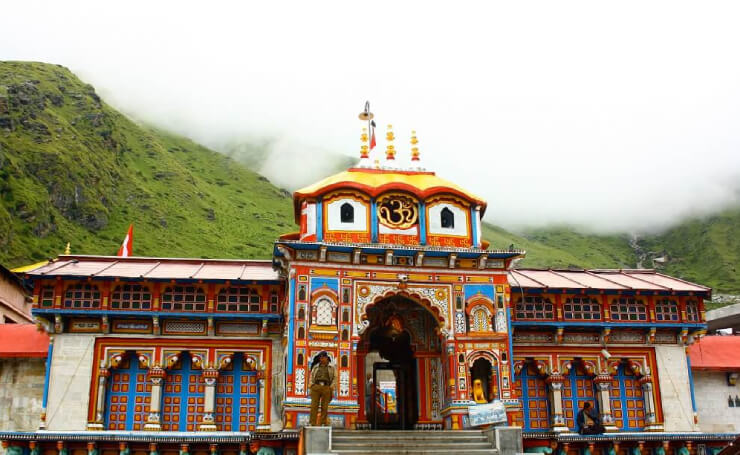
‘Badrinath’ receives its name from ‘Badri’ which means berry in local language. As per the legends, Lord Vishnu performed great penance here and Goddess Lakshmi, consort of Lord Vishnu, shaded him from harsh sun by taking form of berry trees. Best sightseeing places in Badrinath include the following.
- Badrinath Temple– The main shrine is dedicated to Lord Vishnu who is revered here in the dual form of Nar and Narayana. The deity is made of black saligram stone and thousands of pilgrims gather here to seek blessings of the lord.
- Tapt Kund– A natural hot water spring believed to contain medicinal properties. Before entering the main shine, pilgrims need to take a holy dip in the hot waters of this kund.
- Narad Kund– This is another holy kund near Tapt Kund. It is believed that Narad Muni authored ‘Narada Bhakti Sutra’ at this place. Also, this is the place from where Guru Adi Sankaracharya discovered the idol of Lord Vishnu and erected it in the Badrinath Temple.
- Mana Village– It is the last Indian village before Tibet and is home to the ‘Vyas Cave’ and ‘Ganesh Temple’. It is believed that great sage Vyas while composing the Mahabharata took the help of Lord Ganesh to write it in a great speed. Vyas Cave and Ganesh Temple are associated with this legend.
- Bheem Pul– It is a natural rock bridge which according to mythology, is believed to have been constructed by Bheema by laying a huge rock on the Saraswati River, while their ascent to heaven.
- Saraswati River– The Saraswati River holds a great religious significance as it is believed that Rigveda was composed at the banks of this holy river. Also known as the ‘Lost River’ because the river dried away many thousands of years ago, a small stretch of river flowing from the mountains near the Mana Village, merging in the Alaknanda River just a km. ahead, is believed to be the lost Saraswati River.
- Vasudhara Falls– These beautiful falls can be reached through a 6 km. trek from the Mana Village. Captivating views of snow-clad Himalayas and glaciers feeding the Alaknanda River are just a sight to behold at the Vasudhara Falls.
Other Interesting Blog to Read
After the darshans of Lord Badri at Badrinath, pilgrims make their way back to Rishikesh – Haridwar. Following are some additional places that can be seen enroute to return journey.
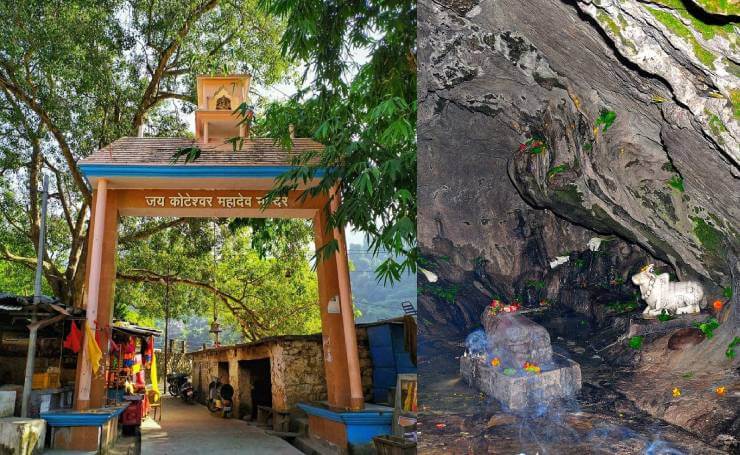
- Koteshwar Temple, Rudraprayag– Situated on the banks of Alaknanda River in a cave, this is one more temple dedicated to Lord Shiva. The temple lies at a distance of 5 km. from the main market of Rudraprayag. According to mythological beliefs, this is the place where Lord Shiva worshipped Lord Vishnu to help him kill the devil, Bhasmasur.
- Hariyali Devi Temple, Rudraprayag– Located at a distance of 35 km. from main town of Rudraprayag, the temple is dedicated to Devi Hariyali, another sacred manifestation of Mata Vaishno Devi. The temple is also one of the 58 ‘Siddha Peeths’ in India. It is believed that when Kansa threw the seventh child of Devki on ground, her body parts fell at different places on earth; with hands falling at Hariyali Devi.
- Kartik Swami Temple, Rudraprayag– Situated at one of the most scenic locations, Kartik Swami Temple is the highlight of Rudraprayag. Perched at a height of 3050m, the temple is devoted to Kartikeya, son of Lord Shiva and Goddess Paravati. Apart from its religious values, the shrine is known for offering indescribable beauty of the Himalayan Range. The temple indeed is the place of tranquility and serenity and is a must visit on Rudraprayag- Nagnath Pokhri Route in Uttarakhand
- Dhari Devi Temple, Srinagar– Located on the banks of Alaknanda River, the deity of Goddess Dhari in the temple is believed to change her appearance from girl to woman to old lady during the course of the day. The temple holds a great religious significance for the locals.
- Kamleshwar Mahadev Temple, Srinagar– The temple is dedicated to Lord Shiva. It is believed that Lord Rama worshipped Lord Shiva at this place with his ‘Kamalnetra’ (Lotus eye). This is the reason temple came to be referred to as ‘Kamleshwar’.
- Raghunath Temple, Devprayag– This is the oldest shrine dedicated to Lord Rama. The temple houses the carved figures of Rama, Sita and Lakshman.
- Brahma Kund and Vashisht Kund, Devprayag– Sacred kunds on confluence of two holy rivers. This kund is on Bhagirathi River.
- Baital Shila, Devprayag– A small water spring which is believed to cure various diseases, especially leprosy.
Well, we hope that through this blog, you were able to see a fair glimpse of places that should be explored in Uttarakhand. Believe us, there are far too many places apart from the ones mentioned here that truly worth all your time. Infact, there are number of places that though at a distance from the major Chota Chardham destinations bear the same significance. Their scenic beauty is something worth beholding and their natural charm is a must-experience in the state.
The ‘Char Dham Pilgrimage Tours embark you on a spiritual journey where you can soak your spirits in true devotion and enlightenment. Besides the spiritual bliss, the tour also takes you through a roller coaster ride of fun and adventure. For more information on the ‘Char Dham’ tour, you are most welcome to raise your queries and enquiries on our blog.
Other Interesting Blogs to Read
Like & Follow our social media accounts at Twitter, Facebook, Linkedin & Instagram for getting the latest updates & offers on holiday packages.
Disclaimer: We do not take credit for some of the licenced paid images used in our blogs, whether from Google Images, Fotolia & Shutterstock. All such images are the copyrights of their respective owners and we try to provide credit for them wherever we can. If, however, any copyright image has been used on our blog, the concerned person can either mail us directly to remove the image or provide credit to whomsoever the image may belong to.
Frequently Asked Questions
What is the best time for the darshan of Char Dham Sites?
For Darshan of Char Dham Sites you can plan your visit in the months of summer (May-June). During winters the sites are inaccessible to the tourists and pilgrims as the entire landscape is covered in snow. Monsoon brings heavy rainfall which also increases the risks of landslides as the road condition worsens in hilly areas. So, Summer is the best time to plan your Char Dham Darshan.
What are the nearest attractions to explore in and around Char Dham sites?
- Phata
- Gandhi Sarovar
- Sonprayag
- Gaurikund Temple
- Vasuki Tal
- Bhairav Temple
- Rudranath Cave
- Srinagar
- Devprayag
- Karnprayag
- Rudraprayag
- Augustmuni
- Pandukeshwar
- Hanuman Chatti
- Joshimath
- Vishwanath Temple
Do we get ATM facilities around Char Dham Sites?
Chances are that you may not get proper ATM Sites around the major shrines but you will get proper ATM Facilities in Rudraprayag, Augustmuni, Guptkashi. Make sure you withdraw cash from here to further your journey.
How are the accommodation facilities around Char Dham?
Around Char Dham sites you will get good accommodation facilities with all the comforts a pilgrim and tourist want. It would be within your budget with facilities like hot water, comfortable bed, vegetarian meal etc. these places are religious places So, you will not get any non-veg food but all the facilities and warm hospitality of the people will definitely elevate your sense of comfort here.
About the author
Having an experience of more than 16 yrs in the Himalayas, Arun is the main driving force & mentor at the Peak Adventure Tours, a leading adventure travel agency in India offers trekking tours in Indian Himalayas including Nepal, Bhutan & Tibet. A long history with exceptional experiences he is the “Marathon Man” in the field of adventure. Today Arun looks after the Peak Adventure and shapes & designs the venture of the organization. He is contributing to this blog as a regular guest author.

 +91-9212777225
+91-9212777225 Plan Your trip
Plan Your trip